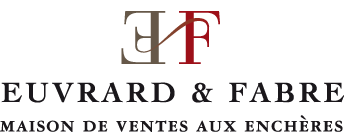Lot n° 382
Estimation :
8000 - 12000
EUR
Result with fees
Result
: 21 760EUR
Large clock with a circular white enamelled... - Lot 382 - Euvrard & Fabre
Large clock with a circular white enamelled dial (splinters at the winding holes) indicating the hours in Roman numerals and the minutes in increments of five in Arabic numerals by two blued steel "Breguet" hands. The movement is housed in a quadrangular case with cut-off sides made entirely of very finely chiselled, patinated and gilded bronze with relief decoration on the sides, with goats rising up on their hind legs to eat branches, and on the front, scenes with figures representing Robinson Crusoe desperate in a makeshift tent facing a storm and the same figure making a boat near a silt worker ; the corners of the box are decorated with barrels from which stylized cacti escape; the terrace, simulating an "au naturel" flowerbed, supports a superb composition representing the meeting of the young savage Vendredi, depicted kneeling on the ground, and Robinson Crusoe, dressed and wearing goatskins, holding a parasol in his right hand and a gun in his other hand; at the back of Vendredi is a siltbush with golden fruits on which a parrot is perched. The whole rests on a quadrangular base with cut sides in antique green marble underlined by a frieze of water leaves alternating with rods; finally, four moulded feet support the clock.
Consulate-Empire period (stamp missing).
Height 55.5 cm, width 37 cm, depth 15 cm
Directly inspired by Daniel Defoe's famous novel published in 1719, this clock, illustrating the meeting of Robinson Crusoe and Friday, is one of the most elaborate watchmaking creations of the last years of the 18th century. Today, among the rare identical models listed, let us mention in particular: a first copy which is illustrated in P. Heuer and K. Maurice, European Pendulum Clocks, Decorative Instruments of Measuring Time, Munich, 1988, p.92, fig.159; as well as a second, featuring a base in red Morello cherry marble from Italy, which is reproduced in P. Kjellberg, Encyclopédie de la clodule française du Moyen Age au XXe siècle, L
My orders
Sale information
Sales conditions
Return to catalogue


